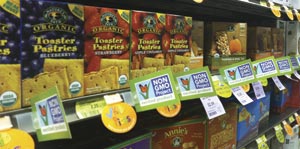BY JEFF HECHT
As you walk down the aisle at your local grocery store, the items on the shelves become a dizzying blur of shapes, sizes, and colors, all packaged to catch your eye (or your stomach!) and lure you into an impulse decision. Manufacturers use pictures, clever names, appealing graphics, and treats inside the box – all entirely designed to create an emotional connection to the cookies, chips, vegetables, meats, and more that
we feed ourselves and our families.
If you take a closer look at that packaging, buried beneath the clever marketing, you’ll find what’s really important – the most essential information about the health and nutritional value of that food, the facts about additives, allergens, and how the food in the package was made.
More and more, consumers have come to recognize the value of the information on the back of the package, and take this knowledge to heart when making decisions about which foods to buy.
Traditionally, food labeling has made shoppers aware of the nutritional value of the food they are looking to purchase – the amount of sugars, calories, additives and preservatives, trans fats, and other information to further educate the consumer regarding their food choices. Adhering to recommended daily allowances has become part of our culture, as healthy consumers seek out alternatives that help maintain a balanced, nutritious diet.
Labels can also notate the inclusion of certain food allergens in the ingredients of consumables, such as of peanuts, milk, soy, shellfish, and others. In 2004, the U.S. Congress passed The Food Allergen Labeling and Consumer Protection Act, mandating that “information about food allergies is written in simple terms adults and children can understand.” According to the Mayo Clinic, foods included in required labeling mandates account for an estimated 90 percent of allergic reactions.
Food dyes and GMOs
In the last few years, even more awareness and importance has been placed on food labeling with regards to the adverse effects of food dyes and the inclusion of genetically modified organisms
(GMOs) in our daily foods.
Food dyes and artificial coloring have been known to cause behavioral issues in consumers, particularly children. Negative side effects in children from ingestion of certain food dyes can include hyperactivity, attention deficits, reduced energy level, lack of focus, and more. Red and yellow food dyes, in particular, have been identified as the most notable source of these behavioral changes in children, yet are present in a staggering number of foods targeting children from breakfast cereals to boxed macaroni and cheese to crackers. When dyes are removed from children’s diets, normal behavioral patterns can return in as little as three days!
GMOs have also been a controversial issue in the food labeling debate. Genetically modified crops such as corn, soybeans, rice, and other food products (as well as cotton and other non-edible crops) have become commonplace, as they show resistance to certain herbicides and pesticides, and have allowed for the sustainable reuse of farmland in a more viable way to generate significantly more yield in crop farming. Increased production means farmers can feed more people using the same amount of resources.
That sounds like a good thing, but there’s another side to the GMO story. Aside from the cross-contamination of pure seeds versus GMO seeds, we look to our health – initial research has shown that there may be side effects to ingesting genetically modified foods, or meat from animals (like cows, chicken, and fish) that were fed GMOs. In his book Genetic Roulette: The Documented Health Risks of Genetically Engineered Foods
, Jeffrey M. Smith, Executive Director of the Institute for Responsible Technology, lists 65 separate health risks identified from consuming GMOs. These health risks include adverse reactions and illness in humans and animals, a decrease in the ability to fight off toxins that enter our body, the creation of certain allergens or proteins or other new and unintended by-products in the genetic process, and the creation of new genes that show the ability to survive and mutate within our bodies.
Right now, in most cases, consumers don’t even know if the food they are eating contains GMOs. The package doesn’t tell you… it doesn’t have to. But in November, voters in the state of California will be the first to go to the polls and decide on the question of mandatory labeling of GMOs. Proponents say that consumers have a right to know what’s in the food they’re eating, while opponents of this proposed legislation acknowledge that research into the health aspects of consuming GMOs is on-going, and altering packaging will affect manufacturers’ ability to continue to provide foods at current prices. Early polling shows a significant lead for proponents of this ballot initiative.
Historically, consumers have dictated to the market what they are willing to pay for their food, and companies that have been proactive about honestly and thoroughly labeling their packages have been embraced by purchasers. As California – as well as a growing number of states – moves to further mandate the labeling of food ingredients, the winner in this debate will be the consumer.
Learn more about GMO labeling:
carighttoknow.org
nativeseeds.org
nongmoproject.org
Jeff Hecht is a Valley Public Relations Consultant and Freelance Writer.
Follow Jeff on Twitter at @JeffHechtAZ.







